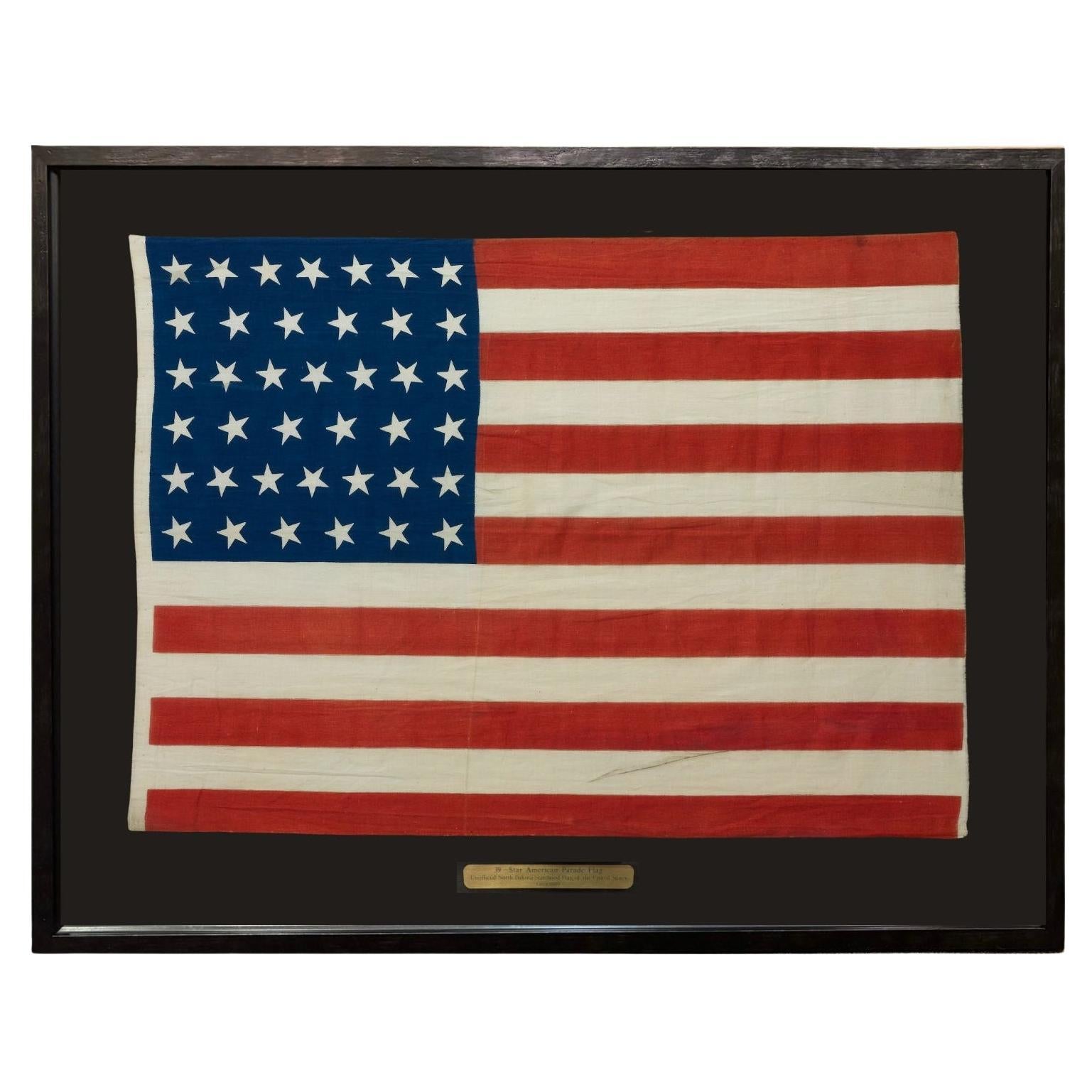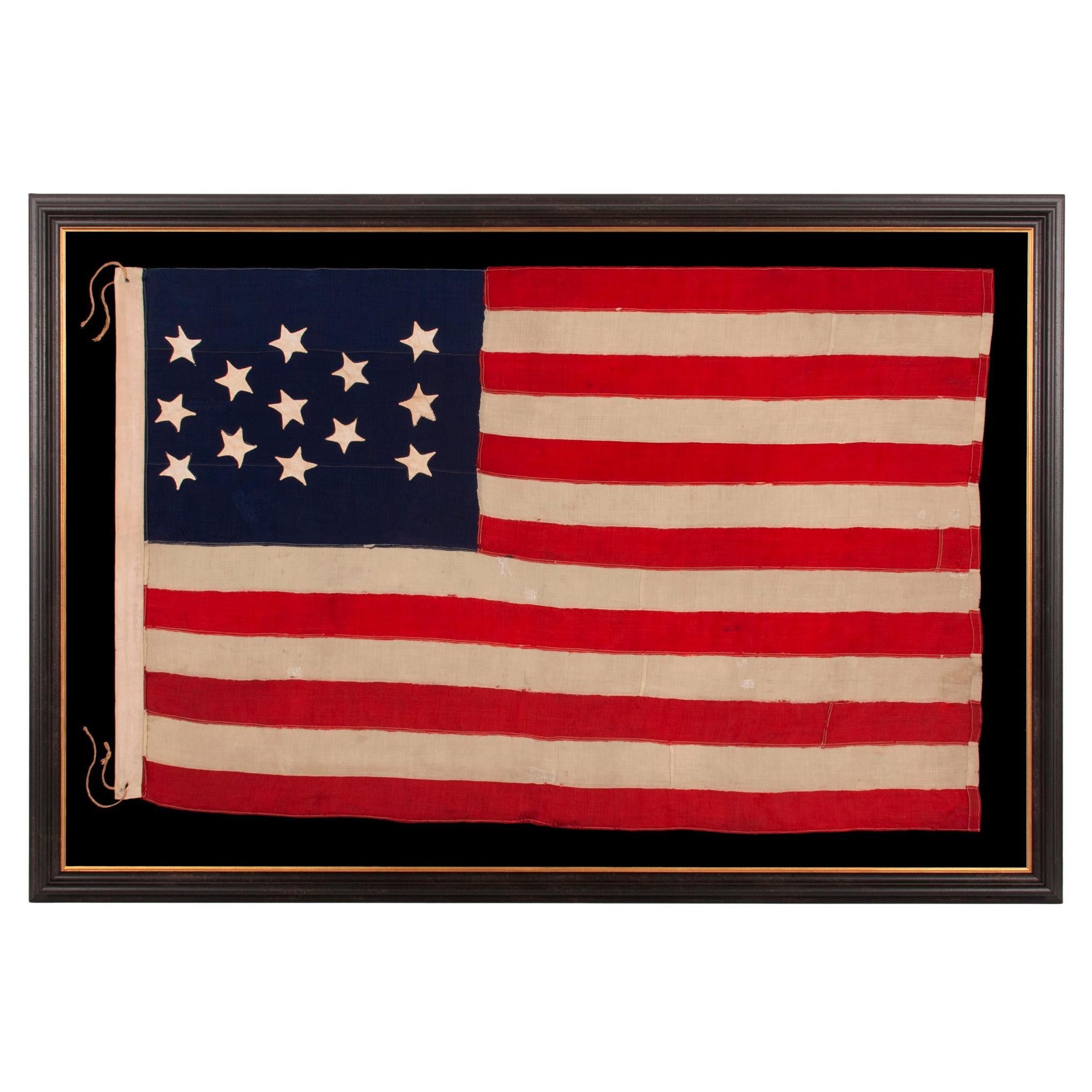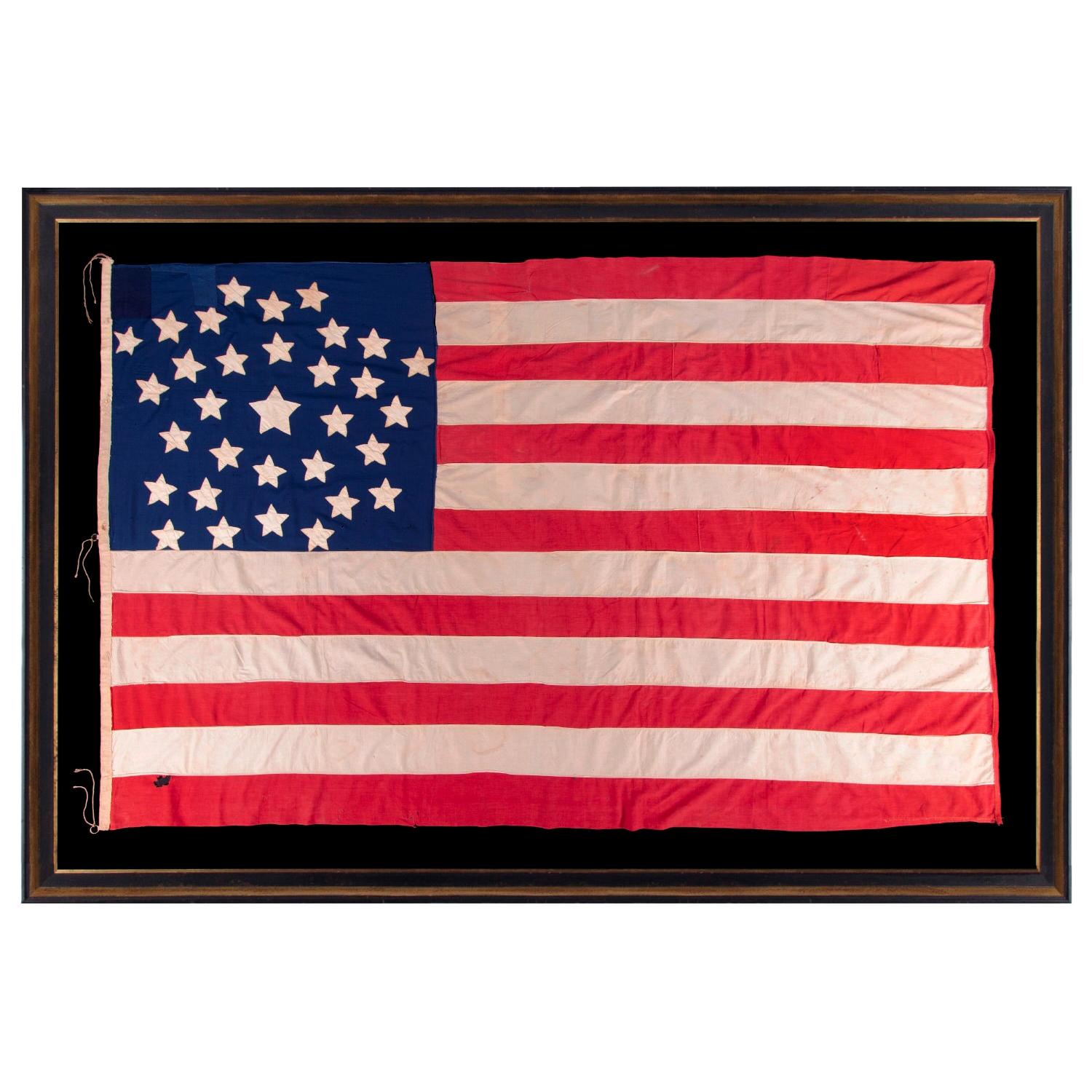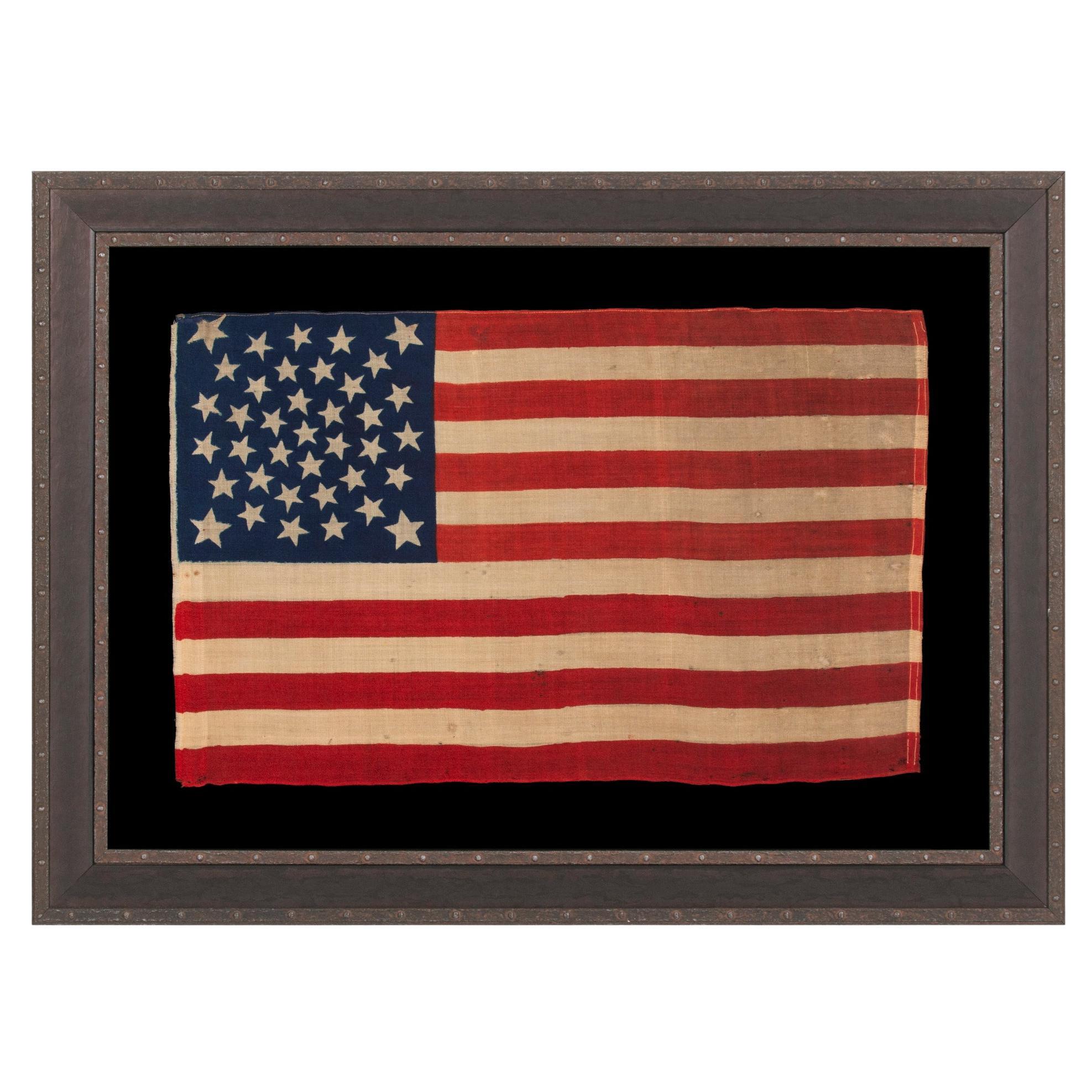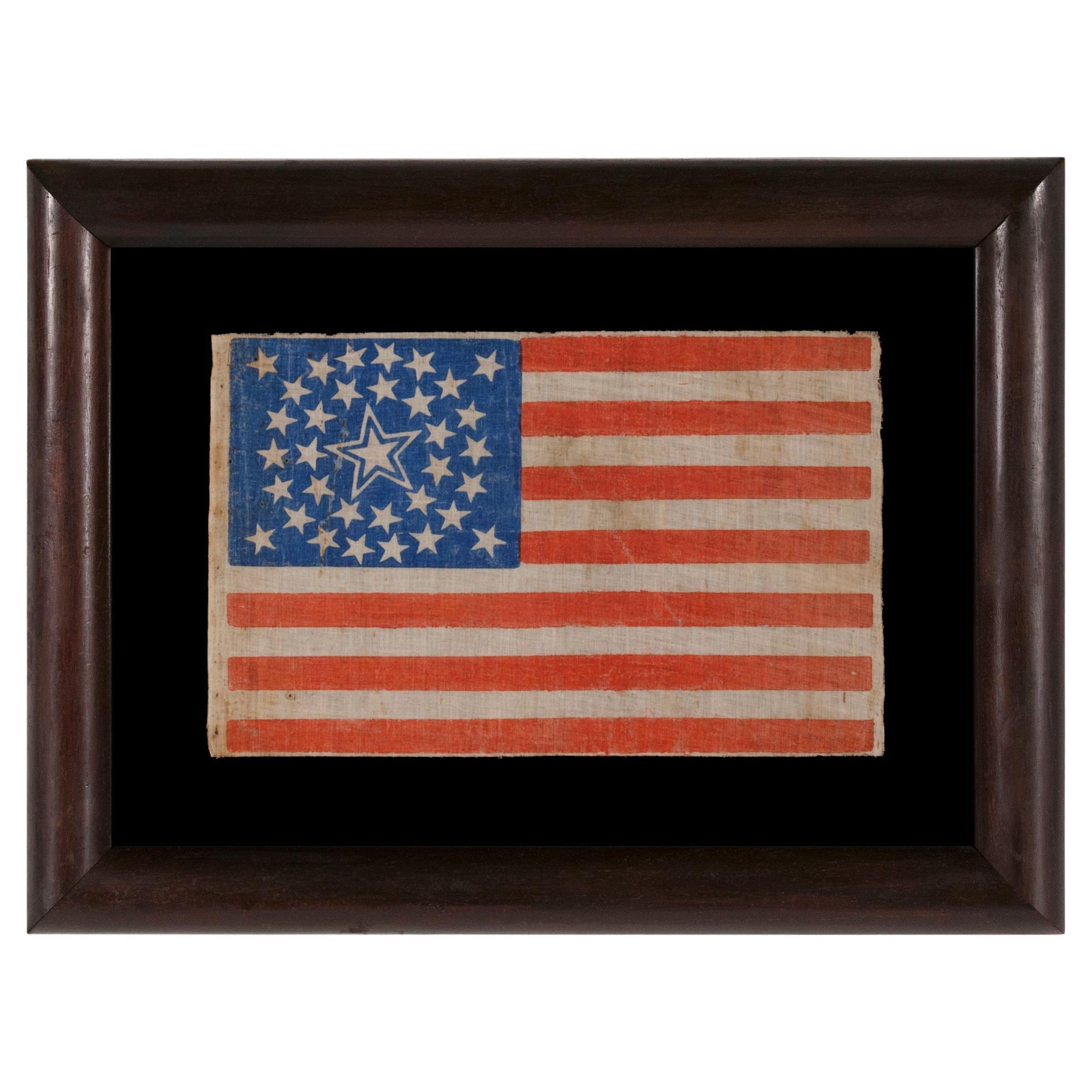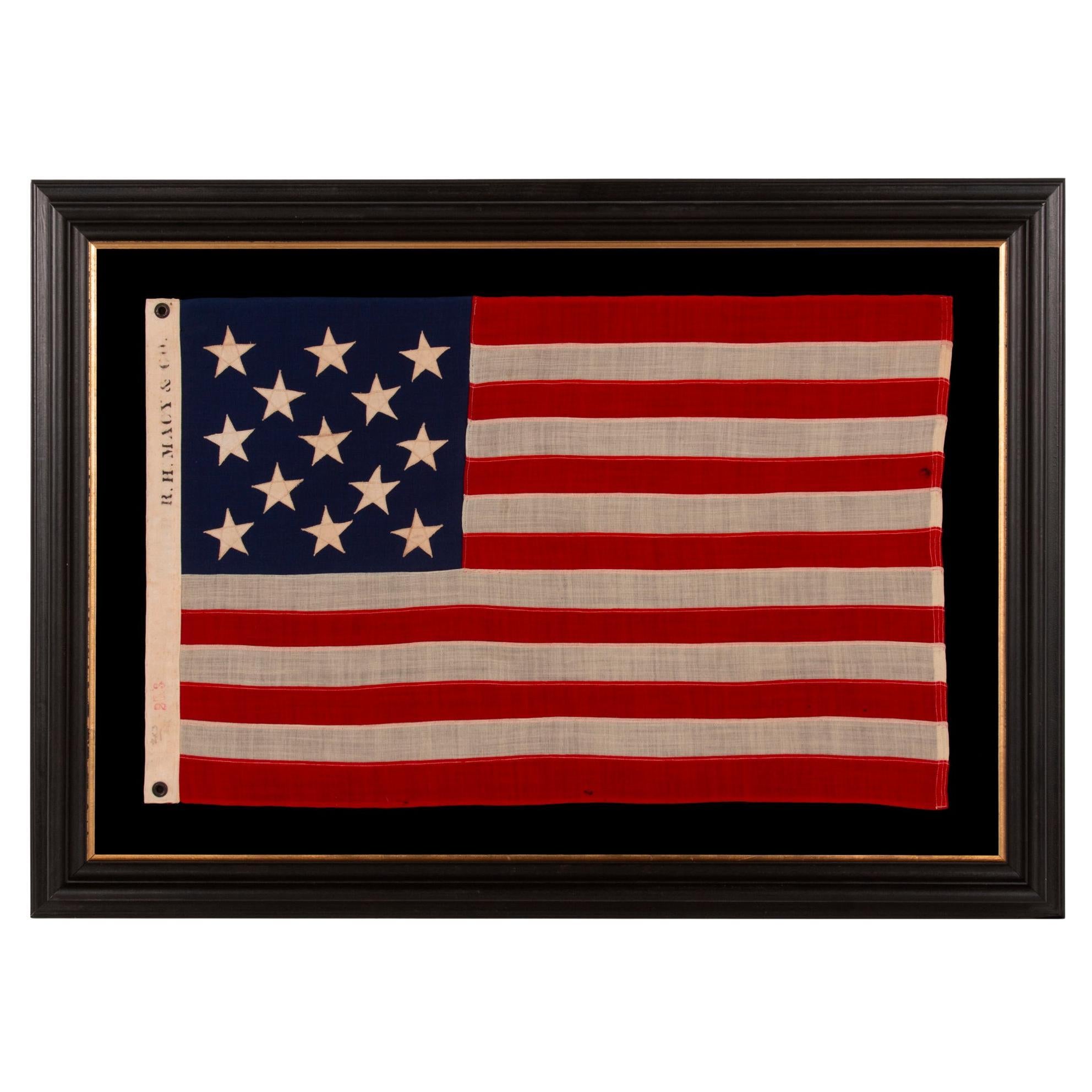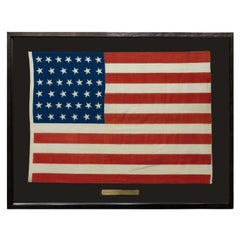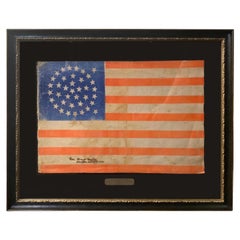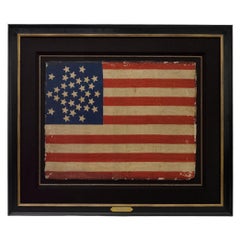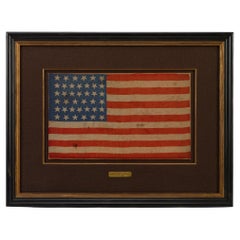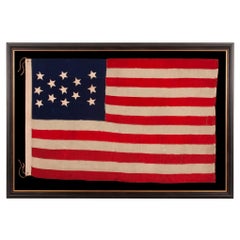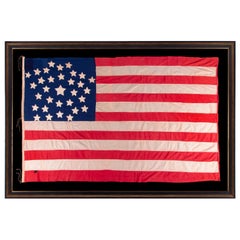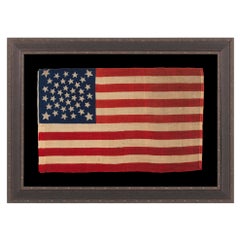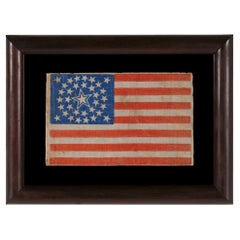Items Similar to 38-Star Antique American Flag with Unique Canton, circa 1876-1890
Video Loading
Want more images or videos?
Request additional images or videos from the seller
1 of 10
38-Star Antique American Flag with Unique Canton, circa 1876-1890
$15,500
£11,769.52
€13,459.32
CA$21,655.75
A$24,085.92
CHF 12,576.92
MX$293,100.01
NOK 160,626.44
SEK 150,639.26
DKK 100,452.08
Shipping
Retrieving quote...The 1stDibs Promise:
Authenticity Guarantee,
Money-Back Guarantee,
24-Hour Cancellation
About the Item
This is a striking 38-star American flag. The flag dates to 1876-1890, when Colorado (represented by the large star in the center of the flag’s canton) joined the Union as the 38th state. A wonderful celebration of our nation's early history, this flag is an authentic antique.
This 38-star American flag is printed with a rare and most unusual canton. The star pattern consists of a large, central great star, surrounded by a medallion of stars and a larger square of stars along the perimeter of the canton. The medallion consists of 13 stars; the outer square consists of 24 stars. Very few flags with this medallion-in-square star pattern are known to exist, even less with a great star at center.
In lead up to the nation’s Centennial in 1876, flag makers and individuals looked to the past for designs to produce as part of the country’s celebration. The 38 stars of this flag are printed in a medallion-in-square arrangement. Medallion patterns became popular with Americans who wanted some variation from “row” patterns that prevailed on the previous 36 and 37 star flags.
The 38th star was added for the admission of Colorado, which occurred on August 1, 1876. Per the Third Flag Act of 1818, stars were not officially added until the 4th of July following a state's addition to the Union. For this reason, 37 was the official star count for the American flag in 1876 and the 38 star flag became the official United States flag on July 4th, 1877. The 38 star flag flew for thirteen years, until 1890. Five presidents served under this flag: Rutherford B. Hayes (1877-1881), James A. Garfield (1881), Chester A. Arthur (1881-1885), Grover Cleveland (1885-1889), and Benjamin Harrison (1889-1893).
Condition:
The flag has staining and soiling throughout, as expected with past use and age. Red stripes have faded and have bled at center of flag, but the blue color in the canton is still very vibrant. A few dark stains on stars, none obscuring star completely. Rust stains exist where three nails originally held flag at hoist. Flag has sound construction with only small trim reduction of bottom red stripe at left lower quadrant. Flag measures: 16” H x 24 ½” W.
Flag is artfully and archivally presented mounted and floating on a brown linen mat. A descriptive gold leafed object plaque is mounted below the flag. The flag is framed in a custom-built black and gold wooden frame. Framed dimensions: 26.5” H x 34” W x 2” D.
- Dimensions:Height: 26.5 in (67.31 cm)Width: 34 in (86.36 cm)Depth: 2 in (5.08 cm)
- Materials and Techniques:Muslin
- Place of Origin:
- Period:
- Date of Manufacture:1876-1890
- Condition:Additions or alterations made to the original: Archival mounting and framing by Art Source International Framing in Boulder, Colorado, in 2017. Wear consistent with age and use. Minor losses. Minor fading.
- Seller Location:Colorado Springs, CO
- Reference Number:Seller: F1991stDibs: LU909717734301
About the Seller
4.9
Platinum Seller
Premium sellers with a 4.7+ rating and 24-hour response times
Established in 2010
1stDibs seller since 2011
461 sales on 1stDibs
- ShippingRetrieving quote...Shipping from: Colorado Springs, CO
- Return Policy
Authenticity Guarantee
In the unlikely event there’s an issue with an item’s authenticity, contact us within 1 year for a full refund. DetailsMoney-Back Guarantee
If your item is not as described, is damaged in transit, or does not arrive, contact us within 7 days for a full refund. Details24-Hour Cancellation
You have a 24-hour grace period in which to reconsider your purchase, with no questions asked.Vetted Professional Sellers
Our world-class sellers must adhere to strict standards for service and quality, maintaining the integrity of our listings.Price-Match Guarantee
If you find that a seller listed the same item for a lower price elsewhere, we’ll match it.Trusted Global Delivery
Our best-in-class carrier network provides specialized shipping options worldwide, including custom delivery.More From This Seller
View All39-Star Antique American Flag with 'Whimsical' Star Pattern, 1889
Located in Colorado Springs, CO
This is a 39-star unofficial American flag, handmade and printed on cotton. The flag dates to 1889 and has a unique history, thanks to its rare star-count.
The flag’s canton is prin...
Category
Antique 1880s American Political and Patriotic Memorabilia
Materials
Cotton
38-Star American Parade Flag, Flown at a Reception for President Grant, 1880
Located in Colorado Springs, CO
This is a beautifully colored 38-star American parade flag, flown at a public reception for Ulysses S. Grant in October of 1880. This printed flag features a rare, triple medallion s...
Category
Antique 1880s American Political and Patriotic Memorabilia
Materials
Cotton
31-Star Printed American Flag, Celebrating California Statehood, Circa 1850
Located in Colorado Springs, CO
This is a rare 31-star medallion printed American flag, celebrating the addition of California to the Union. The flag is printed on silk and has a spectacular “Great Star” canton pat...
Category
Antique 1850s American Political and Patriotic Memorabilia
Materials
Silk
39-Star Printed American Flag, Commemorating North Dakota Statehood, 1889-1890
Located in Colorado Springs, CO
This is a 39-star unofficial American flag, celebrating North Dakota statehood. The printed flag dates to 1889 and showcases a “whimsical” star pattern in the canton. The flag's cant...
Category
Antique 1880s American Political and Patriotic Memorabilia
Materials
Fabric
45-Star American Flag, Printed on Cotton, Celebrating Utah Statehood, 1896-1908
Located in Colorado Springs, CO
This 45-star United States flag celebrates the statehood of Utah. 45-star flags served as the official American flag from 1896-1908. This particular flag was flown as a parade flag. ...
Category
Antique 1890s American Political and Patriotic Memorabilia
Materials
Cotton
Centennial Celebration "1776-1876" American Flag Banner
Located in Colorado Springs, CO
Presented is a rare Centennial patriotic flag banner, dating to 1876. The flag’s brilliant blue canton is spectacular, with 81 five-pointed, rayed stars, arranged to read “1776” and “1876.” The flag’s design is completed with thirteen alternating red and white stripes. The flag is a three-piece, treadle-sewn sewn construction, printed on a thin wool and cotton blend. Along the edge, there is a narrow, treadle-sewn sleeve made of cotton tape.
In the lead up to the nation’s Centennial in 1876, flag makers and individuals looked to the past for designs to produce as part of the country’s many celebrations. Popular interpretation of the stars and stripes undoubtedly reached its climax of variety and originality at the time of our Nation’s first Centennial. Since no design restrictions were placed on flagmaker’s imaginations and no strict distinctions were drawn between official and unofficial star counts, it is no surprise that, on the occasion of the Centennial, creativity in flag design was not the exception, but the rule.
The cantons from this period presented an array of geometric abstractions. Great star patterns, referred to as the “starry flower of Liberty” by Oliver Wendell Holmes, that were popular from 1818 and on, resurfaced in Centennial flags...
Category
Antique 1870s American Political and Patriotic Memorabilia
Materials
Wool, Cotton
You May Also Like
13 Star Antique American Flag with a Narrow Star Presentation, ca 1876
Located in York County, PA
13 STAR ANTIQUE AMERICAN FLAG WITH HAND-SEWN STARS IN AN EXTREMELY NARROW PRESENTATION OF A 3-2-3-2-3 ARRANGEMENT ON A CANTON THAT DOESN’T FOLLOW SUIT, LEAVING WIDE EXPANSES OF BLUE ...
Category
Antique 1870s American Political and Patriotic Memorabilia
Materials
Wool
Price Upon Request
Antique American Flag, 32 Stars, Minnesota Statehood, circa 1858-59
Located in York County, PA
32 STARS IN A VERY UNUSUAL NOTCHED VERSION OF THE “GREAT STAR” PATTERN, WITH TWO STARS ABSENT AT THE EXTREME POINTS OF EACH ARM, MADE IN THE PERIOD WHEN MINNESOTA JOINED THE UNION AS...
Category
Antique 1850s American Political and Patriotic Memorabilia
Materials
Cotton
38 Star American Flag, Colorado Statehood, Made by Horstmann Brothers ca 1876
Located in York County, PA
38 STARS, COLORADO STATEHOOD, A SCARCE AND BEAUTIFUL ANTIQUE AMERICAN FLAG WITH A MEDALLION PATTERN AND 4 LARGE CORNER STARS, PRESS-DYED ON WOOL BUNTING, MADE BY HORSTMANN BROTHERS I...
Category
Antique Late 19th Century American Political and Patriotic Memorabilia
Materials
Wool
34 Star Antique American Parade Flag, Kansas Statehood, ca 1861-1863
Located in York County, PA
34 STARS IN A MEDALLION CONFIGURATION ON AN ANTIQUE AMERICAN PARADE FLAG WITH A LARGE, HALOED CENTER STAR; CIVIL WAR PERIOD, KANSAS STATEHOOD, 1861-1863
34 star American national pa...
Category
Antique 1860s American Political and Patriotic Memorabilia
Materials
Cotton
Price Upon Request
13 Star Antique American Flag, Marked "R.H Macy & Co", circa 1895-1926
Located in York County, PA
13 STAR ANTIQUE AMERICAN FLAG WITH A 3-2-3-2-3 CONFIGURATION OF STARS; A SMALL-SCALE EXAMPLE, MADE IN THE 1895-1926 ERA, MARKED “R.H. MACY & CO.”
13 star antique American flag of th...
Category
Antique Late 19th Century American Political and Patriotic Memorabilia
Materials
Wool
Price Upon Request
13 Star Antique American Flag, Inscribed "Spenge" ca 1895-1926
Located in York County, PA
13 STAR ANTIQUE AMERICAN FLAG WITH A 3-2-3-2-3 CONFIGURATION OF STARS ON AN ATTRACTIVE, INDIGO BLUE CANTON; A SMALL-SCALE EXAMPLE OF THE 1895-1926 ERA, INSCRIBED WITH THE SURNAME “SP...
Category
Antique Late 19th Century American Political and Patriotic Memorabilia
Materials
Wool
More Ways To Browse
American Flag
Used American Flags
Framed American Flag Art
Linen Flag
Large American Flag
Antique American Flags
Union Flag
4th Of July
Antique Blue Canton
Framed American Flags
19th Century American Flag
Centennial 1876
Small American Flag
Antique American Flag Framed
Rust Gold Brown Art
Used Furniture Hayes
Antique Hoist
W Hayes
